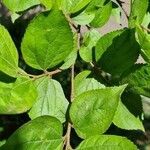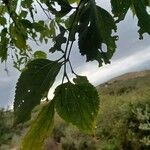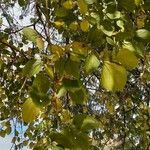Deciduous tree or shrub, 2-30 m high, crown spreading, branches without spines, bark mostly grey and smooth. Leaves alternate, base rounded, slightly asymmetrical, margins serrate in upper 2/3, basal lateral veins one on each side; young foliage often tawny-pubescent on both sides. Inflorescence: male cymose or fasciculate; female axillary, solitary or few-flowered clusters. Flowers usually unisexual, male and female on same plants, along with a few bisexual flowers; pedicellate on branches of current year, appearing with leaves in mid-or late spring. Perianth: lobes 4 or 5; tepals pubescent. Fruit orange to blackish, pubescent pedicels up to 18 mm long. Flowering time Sept.-Dec.
Leaves 3–9 x 2.5–5.5 cm. (juvenile leaves up to 13 x 7 cm.), broadly or narrowly ovate to ovate-lanceolate; apex acuminate; base rounded to cuneate and strongly asymmetrical; margin coarsely dentate-serrate in the upper two thirds, rarely crenate or subentire; lamina thinly or thickly chartaceous, ± scabrous, young foliage often densely tawny-pubescent on both sides, later glabrescent except on nerves below; 3-nerved from the base, basal lateral nerves extending well into upper half, upper lateral nerves 1–2 on each side of the midrib, all lateral nerves prominent below; petiole 2.5–5(10) mm. long; stipules linear to linear-obovate, 3–8 mm. long, pubescent.
Deciduous tree, up to 35 m high. Stems without spines. Bark pale grey, smooth. Leaves with blade ovate, 15-100 x 10-50 mm; base asymmetrical, apex shortly and abruptly tapering, margins entire and coarsely toothed or serrate in upper two-thirds, veining on lower surface prominent with 3 major veins from base, sparsely to densely pubescent. Flowers: in loose clusters; stamens greenish yellow; perianth maroon; Aug., Sep. Fruit a yellow drupe, ovoid, ± 6 mm in diameter.
A tall tree. It grows 10-30 m high. It loses its leaves during the year. The trunk is stout. It has small buttresses near the base. The bark is smooth and grey. The wood has an unpleasant smell. The leaves in spring are soft green and then become dark green. The flowers are small and yellow. The fruit are small and round. They are 5-8 mm across and softly hairy. They are yellow or orange.
Inflorescences precocious; those cymes borne in the lower leaf axils and at the nodes below contain 3-many clustered male flowers on pedicels 1.5–5 mm. long; those cymes borne in the uppermost leaf axils contain 1-several bisexual flowers on pedicels 10–17 mm. long; intermediate cymules consisting of both male and bisexual flowers; axis and pedicels usually densely tawny-pubescent.
A spreading tree to 30(35) m. tall, or a shrub, mostly deciduous, monoecious; bole slightly fluted, bark smooth, whitish-grey often pinkish-blotched; freshly cut wood unpleasant-smelling; young stems and branches densely tawny pubescent-tomentose.
Monoecious, deciduous tree to 30 m, with smooth, grey bark, tawny velvety when young. Leaves obliquely ovate-lanceolate, toothed. Flowers 1-few in axillary cymes, greenish.
Deciduous tree, up to 35 m high. Leaf blades entire, coarsely toothed or serrate in upper two-thirds. Stamens yellow. Drupe yellow. Flowers maroon.
Fruit orange, (4)5–7(8) x 3–6 mm. (dried), subglobose, less often ovoid-ellipsoid, pubescent; pedicels 10–25 mm. long.
Ovary densely pubescent; styles unbranched, 1.5–3.5(4) mm. long.
An understorey forest tree, to 50 ft. or more high
Sepals 4–5, 1.5–2.5 mm. long, pubescent.
Slash mottled dark brown and grey.



